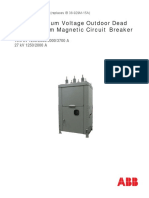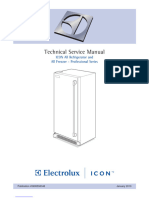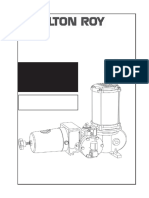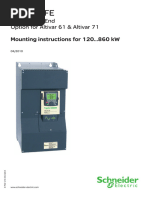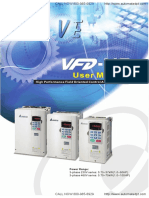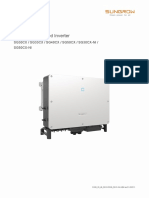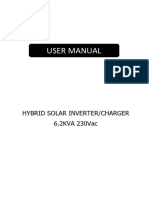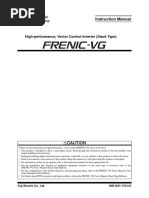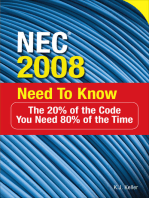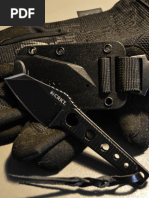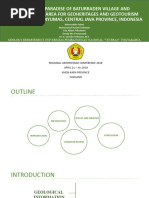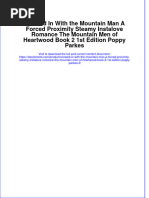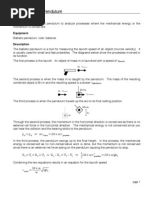ESAB 453cc
ESAB 453cc
Uploaded by
david bolivarCopyright:
Available Formats
ESAB 453cc
ESAB 453cc
Uploaded by
david bolivarOriginal Description:
Copyright
Available Formats
Share this document
Did you find this document useful?
Is this content inappropriate?
Copyright:
Available Formats
ESAB 453cc
ESAB 453cc
Uploaded by
david bolivarCopyright:
Available Formats
F-15-591-A
February, 2001
INSTRUCTION MANUAL
453cc & 553cc
DC WELDING POWER SOURCES
This manual provides complete instructions for the following power sources:
453cc 553cc
Item No. Item No.
ESAB 230/460 vac, 3 ph., 60 Hz 453cc - 0558001274 553cc - 0558001278
ESAB 230/460/575 vac, 3ph., 60 Hz 453cc - 0558001275 553cc - 0558001279
ESAB 220/400 vac, 3 ph., 50 Hz 453cc - 0558001276 553cc - 0558001280
ESAB 220/400 vac, 3 ph., 50 Hz, CE 453cc - 0558001277 553cc - 0558001281
These INSTRUCTIONS are for experienced operators. If you are not fully familiar with the
principles of operation and safe practices for arc welding equipment, we urge you to read our
booklet, "Precautions and Safe Practices for Arc Welding, Cutting, and Gouging," Form 52-
529. Do NOT permit untrained persons to install, operate, or maintain this equipment. Do NOT
attempt to install or operate this equipment until you have read and fully understand these
instructions. If you do not fully understand these instructions, contact your supplier for further
information. Be sure to read the Safety Precautions before installing or operating this
equipment.
Be sure this information reaches the operator.
You can get extra copies through your supplier.
Downloaded from www.Manualslib.com manuals search engine
USER RESPONSIBILITY
This equipment will perform in conformity with the description thereof contained in this manual and accompa-
nying labels and/or inserts when installed, operated, maintained and repaired in accordance with the instruc-
tions provided. This equipment must be checked periodically. Malfunctioning or poorly maintained equipment
should not be used. Parts that are broken, missing, worn, distorted or contaminated should be replaced
immediately. Should such repair or replacement become necessary, the manufacturer recommends that a
telephone or written request for service advice be made to the Authorized Distributor from whom it was pur-
chased.
This equipment or any of its parts should not be altered without the prior written approval of the manufacturer.
The user of this equipment shall have the sole responsibility for any malfunction which results from improper
use, faulty maintenance, damage, improper repair or alteration by anyone other than the manufacturer or a
service facility designated by the manufacturer.
PREFACE
The purpose of this manual is to provide the operator with information required to install and operate
the power source. Some technical reference material is also provided to assist in basic troubleshooting
the power source. If it is determined that the power source is not operating properly, the operator should
contact ESAB at (843) 664-4416 for assistance.
The following is a list of terms/acronyms used throughout this manual.
CC Constant Current
CV Constant Voltage
GMAW Gas Metal Arc Welding, CV mode (same as MIG)
GMAW-P Gas Metal Arc Welding - Pulsed, CV mode (same as pulsed MIG)
GTAW Gas Tungsten Arc Welding, CC mode (same as TIG)
MIG Metal Inert Gas, CV mode (same as GMAW)
SMAW Shielded Metal Arc Welding, CC mode (same as Stick)
Stick Stick Welding, CC mode (same as SMAW)
TIG Tungsten Inert Gas, CC mode (same as GTAW)
Downloaded from www.Manualslib.com manuals search engine
TABLE OF CONTENTS
SECTION
PARAGRAPH TITLE PAGE
SAFETY
ENGLISH SAFETY PRECAUTIONS ................................................................................................................ 4, 5
FRENCH SAFETY PRECAUTIONS ................................................................................................................ 6, 7
SECTION 1 DESCRIPTION ..................................................................................................................................... 8
1.1 General ................................................................................................................................................ 8
1.2 Receiving-Handling .............................................................................................................................. 8
1.3 Description ........................................................................................................................................... 8
1.3.1 Power Source ...................................................................................................................................... 8
1.3.2 Volt-Ampere Characteristics ................................................................................................................ 9
1.4 Optional Accessories ........................................................................................................................... 9
1.5 Safety ................................................................................................................................................... 9
SECTION 2 INSTALLATION ................................................................................................................................... 10
2.1 Location ............................................................................................................................................... 10
2.2 Receiving, Unpacking and Placement ................................................................................................. 10
2.3 Primary (Input) Electrical Connection .................................................................................................. 10
2.4 Secondary (Output) Welding Connections .......................................................................................... 12
2.5 Control Connections ............................................................................................................................ 12
SECTION 3 OPERATION ........................................................................................................................................ 14
3.1 Controls ................................................................................................................................................ 14
3.1.1 Power Switch (ON-OFF) ..................................................................................................................... 14
3.1.2 Arc Force Control ................................................................................................................................ 14
3.1.3 Contactor Or/Remote Switch ............................................................................................................... 14
3.1.4 Current Panel/Remote Switch ............................................................................................................. 14
3.1.5 Current Control .................................................................................................................................... 14
3.1.6 Over Temperature Indicator ................................................................................................................. 15
3.1.7 Voltmeter and Ammeter ....................................................................................................................... 15
3.1.8 Fault indicator ...................................................................................................................................... 15
3.2 Operation Set-Up ................................................................................................................................. 15
3.2.1 Stick Welding, Arc Gouging, Tig Welding ............................................................................................ 15
3.2.2 Mig Spray Arc and Flux Cored Welding ............................................................................................... 15
SECTION 4 MAINTENANCE ................................................................................................................................... 16
4.1 General ................................................................................................................................................ 16
4.2 Cleaning ............................................................................................................................................... 16
4.3 Inspection .and Service ....................................................................................................................... 16
4.3.1 Fan Motor ............................................................................................................................................. 16
4.3.2 Transformer .......................................................................................................................................... 16
4.3.3 Control Circuit ...................................................................................................................................... 16
4.3.4 Over Temperature Protection ............................................................................................................... 16
4.3.5 Digital Voltmeter/Ammeter Calibration ................................................................................................. 16
SECTION 5 TROUBLESHOOTING ......................................................................................................................... 17
5.1 General ................................................................................................................................................ 17
5.2 Testing and Replacing Bridge Assembly Components ........................................................................ 17
5.3 PCB Voltage Test ................................................................................................................................. 17
5.6 Troubleshooting Information Table ....................................................................................................... 18
SECTION 6 PARTS ................................................................................................................................................. 19
6.1 General ................................................................................................................................................ 19
6.2 Ordering ............................................................................................................................................... 19
Downloaded from www.Manualslib.com manuals search engine
SAFETY PRECAUTIONS
WARNING: These Safety Precautions are for 5. Do not use equipment beyond its ratings. For example,
your protection. They summarize precaution- overloaded welding cable can overheat and create a fire
ary information from the references listed in hazard.
Additional Safety Information section. Before 6. After completing operations, inspect the work area to
performing any installation or operating procedures, be make certain there are no hot sparks or hot metal which
sure to read and follow the safety precautions listed below could cause a later fire. Use fire watchers when neces-
as well as all other manuals, material safety data sheets, sary.
labels, etc. Failure to observe Safety Precautions can result 7. For additional information, refer to NFPA Standard 51B,
in injury or death. "Fire Prevention in Use of Cutting and Welding Pro-
cesses", available from the National Fire Protection Asso-
PROTECT YOURSELF AND OTHERS --
ciation, Batterymarch Park, Quincy, MA 02269.
Some welding, cutting, and gouging
processes are noisy and require ear
ELECTRICAL SHOCK -- Contact with live
protection. The arc, like the sun, emits
electrical parts and ground can cause
ultraviolet (UV) and other radiation and
severe injury or death. DO NOT use AC
can injure skin and eyes. Hot metal can cause burns.
welding current in damp areas, if move-
Training in the proper use of the processes and equip-
ment is confined, or if there is danger of
ment is essential to prevent accidents. Therefore:
falling.
1. Always wear safety glasses with side shields in any work
1. Be sure the power source frame (chassis) is connected
area, even if welding helmets, face shields, and goggles
are also required. to the ground system of the input power.
2. Use a face shield fitted with the correct filter and cover 2. Connect the workpiece to a good electrical ground.
plates to protect your eyes, face, neck, and ears from 3. Connect the work cable to the workpiece. A poor or
sparks and rays of the arc when operating or observing missing connection can expose you or others to a fatal
operations. Warn bystanders not to watch the arc and shock.
not to expose themselves to the rays of the electric-arc 4. Use well-maintained equipment. Replace worn or dam-
or hot metal. aged cables.
3. Wear flameproof gauntlet type gloves, heavy long-sleeve 5. Keep everything dry, including clothing, work area, cables,
shirt, cuffless trousers, high-topped shoes, and a weld- torch/electrode holder, and power source.
ing helmet or cap for hair protection, to protect against 6. Make sure that all parts of your body are insulated from
arc rays and hot sparks or hot metal. A flameproof apron work and from ground.
may also be desirable as protection against radiated
7. Do not stand directly on metal or the earth while working
heat and sparks.
in tight quarters or a damp area; stand on dry boards or
4. Hot sparks or metal can lodge in rolled up sleeves,
trouser cuffs, or pockets. Sleeves and collars should be an insulating platform and wear rubber-soled shoes.
kept buttoned, and open pockets eliminated from the 8. Put on dry, hole-free gloves before turning on the power.
front of clothing 9. Turn off the power before removing your gloves.
5. Protect other personnel from arc rays and hot sparks 10. Refer to ANSI/ASC Standard Z49.1 (listed on next page)
with a suitable non-flammable partition or curtains. for specific grounding recommendations. Do not mis-
6. Use goggles over safety glasses when chipping slag or take the work lead for a ground cable.
grinding. Chipped slag may be hot and can fly far.
Bystanders should also wear goggles over safety glasses. ELECTRIC AND MAGNETIC FIELDS —
May be dangerous. Electric current flow-
FIRES AND EXPLOSIONS -- Heat from ing through any conductor causes lo-
flames and arcs can start fires. Hot slag calized Electric and Magnetic Fields
or sparks can also cause fires and ex- (EMF). Welding and cutting current cre-
plosions. Therefore: ates EMF around welding cables and
welding machines. Therefore:
1. Remove all combustible materials well away from the
work area or cover the materials with a protective non- 1. Welders having pacemakers should consult their physi-
flammable covering. Combustible materials include wood, cian before welding. EMF may interfere with some pace-
cloth, sawdust, liquid and gas fuels, solvents, paints and
makers.
coatings, paper, etc.
2. Hot sparks or hot metal can fall through cracks or 2. Exposure to EMF may have other health effects which are
crevices in floors or wall openings and cause a hidden unknown.
smoldering fire or fires on the floor below. Make certain 3. Welders should use the following procedures to minimize
that such openings are protected from hot sparks and exposure to EMF:
metal.“ A. Route the electrode and work cables together. Secure
3. Do not weld, cut or perform other hot work until the them with tape when possible.
workpiece has been completely cleaned so that there B. Never coil the torch or work cable around your body.
are no substances on the workpiece which might pro- C. Do not place your body between the torch and work
duce flammable or toxic vapors. Do not do hot work on cables. Route cables on the same side of your body.
closed containers. They may explode. D. Connect the work cable to the workpiece as close as
4. Have fire extinguishing equipment handy for instant use, possible to the area being welded.
such as a garden hose, water pail, sand bucket, or
E. Keep welding power source and cables as far away
portable fire extinguisher. Be sure you are trained in its
from your body as possible.
use.
10/98
4
Downloaded from www.Manualslib.com manuals search engine
SAFETY PRECAUTIONS
FUMES AND GASES -- Fumes and EQUIPMENT MAINTENANCE -- Faulty or
gases, can cause discomfort or harm, improperly maintained equipment can
particularly in confined spaces. Do cause injury or death. Therefore:
not breathe fumes and gases. Shield-
ing gases can cause asphyxiation. 1. Always have qualified personnel perform the installa-
Therefore: tion, troubleshooting, and maintenance work. Do not
perform any electrical work unless you are qualified to
1. Always provide adequate ventilation in the work area by perform such work.
natural or mechanical means. Do not weld, cut, or gouge 2. Before performing any maintenance work inside a power
on materials such as galvanized steel, stainless steel, source, disconnect the power source from the incoming
copper, zinc, lead, beryllium, or cadmium unless posi- electrical power.
tive mechanical ventilation is provided. Do not breathe 3. Maintain cables, grounding wire, connections, power
fumes from these materials. cord, and power supply in safe working order. Do not
2. Do not operate near degreasing and spraying opera- operate any equipment in faulty condition.
tions. The heat or arc rays can react with chlorinated 4. Do not abuse any equipment or accessories. Keep
hydrocarbon vapors to form phosgene, a highly toxic equipment away from heat sources such as furnaces,
gas, and other irritant gases. wet conditions such as water puddles, oil or grease,
3. If you develop momentary eye, nose, or throat irritation corrosive atmospheres and inclement weather.
while operating, this is an indication that ventilation is not 5. Keep all safety devices and cabinet covers in position
adequate. Stop work and take necessary steps to im- and in good repair.
prove ventilation in the work area. Do not continue to 6. Use equipment only for its intended purpose. Do not
operate if physical discomfort persists. modify it in any manner.
4. Refer to ANSI/ASC Standard Z49.1 (see listing below)
for specific ventilation recommendations. ADDITIONAL SAFETY INFORMATION -- For
5. WARNING: This product, when used for welding or more information on safe practices for elec-
cutting, produces fumes or gases which tric arc welding and cutting equipment, ask
contain chemicals known to the State of your supplier for a copy of "Precautions and
California to cause birth defects and, in Safe Practices for Arc Welding, Cutting and
some cases, cancer. (California Health & Gouging", Form 52-529.
Safety Code §25249.5 et seq.)
The following publications, which are available from the
American Welding Society, 550 N.W. LeJuene Road, Mi-
CYLINDER HANDLING -- Cylinders, if
ami, FL 33126, are recommended to you:
mishandled, can rupture and violently
1. ANSI/ASC Z49.1 - "Safety in Welding and Cutting"
release gas. Sudden rupture of cylin-
2. AWS C5.1 - "Recommended Practices for Plasma Arc
der, valve, or relief device can injure or
Welding"
kill. Therefore:
3. AWS C5.2 - "Recommended Practices for Plasma Arc
Cutting"
1. Use the proper gas for the process and use the proper
4. AWS C5.3 - "Recommended Practices for Air Carbon
pressure reducing regulator designed to operate from
Arc Gouging and Cutting"
the compressed gas cylinder. Do not use adaptors.
5. AWS C5.5 - "Recommended Practices for Gas Tung-
Maintain hoses and fittings in good condition. Follow
sten Arc Welding“
manufacturer's operating instructions for mounting regu-
6. AWS C5.6 - "Recommended Practices for Gas Metal Arc
lator to a compressed gas cylinder.
Welding"“
2. Always secure cylinders in an upright position by chain
7. AWS SP - "Safe Practices" - Reprint, Welding Hand-
or strap to suitable hand trucks, undercarriages, benches,
book.
walls, post, or racks. Never secure cylinders to work
8. ANSI/AWS F4.1, "Recommended Safe Practices for
tables or fixtures where they may become part of an
Welding and Cutting of Containers That Have Held
electrical circuit.
Hazardous Substances."
3. When not in use, keep cylinder valves closed. Have
valve protection cap in place if regulator is not con-
MEANING OF SYMBOLS - As used through-
nected. Secure and move cylinders by using suitable
out this manual: Means Attention! Be Alert!
hand trucks. Avoid rough handling of cylinders.
Your safety is involved.
4. Locate cylinders away from heat, sparks, and flames.
Never strike an arc on a cylinder. Means immediate hazards which, if
5. For additional information, refer to CGA Standard P-1, not avoided, will result in immediate,
"Precautions for Safe Handling of Compressed Gases in serious personal injury or loss of life.
Cylinders", which is available from Compressed Gas
Association, 1235 Jefferson Davis Highway, Arlington, Means potential hazards which could
VA 22202. result in personal injury or loss of life.
Means hazards which could result in
minor personal injury.
5 SP98-10
Downloaded from www.Manualslib.com manuals search engine
PRÉCAUTIONS DE SÉCURITÉ
AVERTISSEMENT: Ces règles de sécurité ont pour objet coupes à l’arc, à moins de les recouvrir complètement
d’ assurer votre protection. Veillez à lire et à observer les d’une bâche non-inflammable. Ce type de matériaux
précautions énoncées ci-dessous avant de monter l’ comprend notamment le bois, les vêtements, la sciure,
équipement ou de commercer à l’utiliser. Tout défaut l’essence, le kérosène, les peintures, les solvants, le
d’observation de ces précautions risque d’entraîner des gaz naturel, l’acétylène, le propane et autres sub-
blessures graves ou mortelles. stances combustibles semblables.
1. PROTECTION INDIVIDUELLE-- Les brûlures de la b. Les étincelles ou les projections de métal incandes-
peau et des yeux dues au rayonnement de l’arc cent peuvent tomber dans des fissures du plancher ou
électrique ou du métal incandescent, lors du soudage dans des ouvertures des murs et y déclencher une
au plasma ou à l’électrode ou lors du gougeage à ignition lente cachée. Veiller à protéger ces ouvertures
l’arc, peuvent s’avérer plus graves que celles des étincelles et des projections de métal.
résultant d’une exposition prolongée au soleil. Aussi c. N’exécutez pas de soudures, de coupes, d’opérations
convient-il d’observer les précautions suivantes: de gougeage ou autres travaux à chaud à la surface
a. Portez un écran facial adéquat muni des plaques de barils, bidons, réservoirs ou autres contenants
protectrices et des verres filtrants appropriés afin de usagés, avant de les avoir nettoyés de toute trace de
vous protéger les yeux, le visage, le cou et les oreilles substance susceptible de produire des vapeurs
des étincelles et du rayonnement de l’arc électrique inflammables ou toxiques.
lorsque vous effectuez des soudures ou des coupes d. En vue d’assurer la prévention des incendies, il
ou lorsque vous en observez l’exécution. convient de disposer d’un matériel d’extinction prêt à
AVERTISSEZ les personnes se trouvant à proximité servir immédiatement, tel qu’un tuyau d’arrosage, un
de façon à ce qu’elles ne regardent pas l’arc et à ce seau à eau, un seau de sable ou un extincteur portatif.
qu’elles ne s’exposent pas à son rayonnement, ni à e. Une fois le travail à l’arc terminé, inspectez le secteur
celui du métal incandescent. de façon à vous assurer qu’aucune étincelle ou projec-
b. Portez des gants ignifugés à crispins, une tunique tion de métal incandescent ne risque de provoquer
épaisse à manches longues, des pantalons sans ultérieurement un feu.
rebord, des chaussures à embout d’acier et un 3. CHOC ÉLECTRIQUE-- Le gougeage à l’arc et à l’arc
casque de soudage ou une calotte de protection, afin au plasma exige l’emploi de tensions à vide
d’éviter d’exposer la peau au rayonnement de l’arc relativement importantes; or, celles-ci risquent de
électrique ou du métal incandescent. ll est également causer des dommages corporels graves et même
souhaitable d’utiliser un tablier ininflammable de mortels en cas d’utilisation inadéquate. La gravité du
façon à se protéger des étincelles et du rayonnement choc électrique reçu dépend du chemin suivi par le
thermique. courant à travers le corps humain et de son intensité.
c. Les étincelles ou les projections de métal incandes- a. Ne laissez jamais de surfaces métalliques sous ten-
cent risquent de se loger dans des manches sion venir au contact direct de la peau ou de
retroussées, des bords relevés de pantalons ou dans vêtements humides. Veillez à porter des gants bien
des poches. Aussi convient-il de garder boutonnés le secs.
col et les manches et de porter des vêtements sans b. Si vous devez effectuer un travail sur une surface
poches à l’avant. métallique ou dans un secteur humide, veillez à assu-
d. Protégez des étincelles et du rayonnement de l’arc rer votre isolation corporelle en portant des gants secs
électrique les autres personnes travaillant à proximité et des chaussures à semelles de caoutchouc et en
à l’aide d’un écran ininflammable adéquat. vous tenant sur une planche ou une plate-forme
e. Ne jamais omettre de porter des lunettes de sécurité sèche.
lorsque vous vous trouvez dans un secteur où l’on c. Mettez toujours à la terre le poste de soudage/coupage
effectue des opérations de soudage ou de coupage à en le reliant par un câble à une bonne prise de terre.
l’arc. Utilisez des lunettes de sécurité à écrans ou d. N’utilisez jamais de câbles usés ou endommagés. Ne
verres latéraux pour piquer ou meûler le laitier. Les surchargez jamais le câble. Utilisez toujours un
piquetures incandescentes de laitier peuvent être équipement correctement entretenu.
projetées à des distances considérables. Les e. Mettez l’équipement hors tension lorsqu’il n’est pas en
personnes se trouvant à proximité doivent également service. une mise à la masse accidentelle peut en effet
porter des lunettes de protection. provoquer une surchauffe de l’équipement et un dan-
f. Le gougeage à l’arc et le soudage à l’arc au plasma ger d’incendie. Ne pas enrouler ou passer le câble
produisent un niveau de bruit extrêmement élevé (de autour d’une partie quelconque du corps.
100 à 114 dB) et exigent par conséquent l’emploi de f. Vérifiez si le câble de masse est bien relié à la pièce en
dispositifs appropriés de protection auditive. un point aussi proche que possible de la zone de
2. PRÉVENTION DES INCENDES-- Les projections de travail. Le branchement des câbles de masse à
laitier incandescent ou d’étincelles peuvent l’ossature du bâtiment ou en un point éloigné de la
provoquer de graves incendies au contact de zone de travail augmente en effet le risque de pas-
matériaux combustibles solides, liquides ou gazeux. sage d’un courant de sortie par des chaînes de
Aussi faut-il observer les précautions suivantes:
a. Éloigner suffisamment tous les matériaux combus-
tibles du secteur où l’on exécute des soudures ou des
6 9/97
Downloaded from www.Manualslib.com manuals search engine
PRÉCAUTIONS DE SÉCURITÉ
levage, des câbles de grue ou divers chemins déclenchant des incendies ou des chocs électriques.
électriques. Observez par conséquent les précautions suivantes:
g. Empêchez l’apparition de toute humidité, notamment a. Efforcez-vous de toujours confier à un personnel qua-
sur vos vêtements, à la surface de l’emplacement de lifié l’installation, le dépannage et l’entretien du poste
travail, des câbles, du porte-électrode et du poste de de soudage et de coupage. N’effectuez aucune
soudage/coupage. Réparez immédiatement toute réparation électrique sur l’équipement à moins d’être
fuite d’eau. qua-lifié à cet effet.
4. VENTILATION-- La respiration prolongée des fumées b. Ne procédez jamais à une tâche d’entretien
résultant des opérations de soudage/coupage, à quelconque à l’intérieur du poste de soudage/
l’intérieur, d’un local clos, peut provoquer des mal- coupage, avant d’avoir débranché l’alimentation
aises et des dommages corporels. Aussi convient-il électrique.
d’observer les précautions suivantes: c. Maintenez en bon état de fonctionnement les câbles,
a. Assurez en permanence une aération adéquate de le câble de masse, les branchements, le cordon
l’emplacement de travail en maintenant une ventila- d’alimentation et le poste de soudage/coupage.
tion naturelle ou à l’aide de moyens mécaniques. N’utilisez jamais le poste ou l’équipement s’il présente
N’effectuez jamais de travaux de soudage ou de une défectuosité quelconque.
coupage sur des matériaux de zinc, de plomb, de d. Prenez soin du poste de soudage et de coupage et des
beryllium ou de cadmium en l’absence de moyens équipements accessoires. Gardez-les à l’écart des
mécaniques de ventilation capables d’empêcher sources de charleur, notamment des fours, de
l’inhalation des fumées dégagées par ces matériaux. l’humidité, des flaques d’eau maintenez-les à l’abri des
b. N’effectuez jamais de travaux de soudage ou de traces d’huile ou de graisse, des atmosphères corro-
coupage à proximité de vapeurs d’hydrocarbure sives et des intempéries.
chloré résultant d’opérations voisines de dégraissage e. Laissez en place tous les dispositifs de sécurité et tous
ou de pulvérisation. La chaleur dégagée ou le les panneaux de l’armoire de commande en veillant à
rayonnement de l’arc peut déclencher la formation de les garder en bon état.
phosgène -- gaz particulièrement toxique -- et d’autres f. Utilisez le poste de soudage/coupage conformément à
gaz irritants, à partir des vapeurs de solvant. son usage prévu et n’effectuez aucune modification.
c. Une irritation momentanée des yeux, du nez ou de la 6. INFORMATIONS COMPLÉMENTAIRES RELATIVES
gorge constatée au cours de l’utilisation de À LA SÉCURITÉ--
l’équipement dénote un défaut de ventilation. Arrêtez- Pour obtenir des informations complémentaires sur les
vous de travailler afin de prendre les mesures néces- règles de sécurité à observer pour le montage et
saires à l’amélioration de la ventilation. Ne poursuivez l’utilisation d’équipements de soudage et de coupage
pas l’opération entreprise si le malaise persiste. électriques et sur les méthodes de travail
d. Certaines commandes comportent des canalisations recommandées, demandez un exemplaire du livret N°
où circule de l’hydrogène. L’armoire de commande est 52529 “Precautions and Safe Practices for Arc Weld-
munie d’un ventilateur destiné à empêcher la forma- ing, Cutting and Gouging” publié par ESAB. Nous
tion de poches d’hydrogène, lesquelles présentent un conseillons également de consulter les publications
danger d’explosion; ce ventilateur ne fonctionne que sui-vantes, tenues à votre disposition par l’American
si l’interrupteur correspondant du panneau avant se Welding Society, 550 N.W. LeJuene Road, Miami, FL
trouve placé en position ON (Marche). Veillez à 32126:
manœuvrer cette commande en vérifiant si le a. “Safety in Welding and Cutting” AWS Z49.1
couvercle est bien en place, de façon à assurer b. “Recommended Safe Practices for Gas-Shielded Arc
l’efficacité de la ventilation ainsi réalisée. Ne jamais Welding “AWS A6. 1.
débrancher le ventilateur. c. “Safe Practices for Welding and Cutting Containers
e. Les fumées produites par l’opération de soudage ou That Have Held Combustibles” AWS-A6.0.
de coupage peuvent s’avérer toxiques. Aussi est-il d. “Recommended Safe Practices for Plasma Arc Cutting”
nécessaire de disposer en permanence d’un dispositif AWS-A6. 3.
adéquat de ventilation de type aspirant, afin d’élimi- e. “Recommended Safe Practices for Plasma Arc Weld-
ner du voisinage de l’opérateur tout dégagement de ing” AWS-C5. 1.
fumée visible. f. “Recommended Safe Practices for Air Carbon Arc
f. Consultez les recommandations particulières en Gouging and Cutting” AWS-C5. 3.
matière de ventilation indiquées à l’alinéa 6 de la g. “Code For Safety in Welding and Cutting”
norme Z49.1 de l’AWS. CSA-Standard W117. 2.
5. ENTRETIEN DE L’ÉQUIPEMENT-- Un équipement
entretenu de façon défectueuse ou inadéquate risque
non seulement de réaliser un travail de mauvaise
qualité mais, chose plus grave encore, d’entraîner des
dommages corporels graves, voire mortels en
7 9/97
Downloaded from www.Manualslib.com manuals search engine
SECTION 1 DESCRIPTION
1.1 GENERAL
When requesting information concerning this equip-
This manual has been prepared for use by an experi- ment, it is essential that Item number, Serial number
enced operator. It provides information to familiarize and Model number of the equipment be supplied.
the operator with the design, installation and operation
of the 482cc and 582cc model power sources. DO NOT 1.3 DESCRIPTION
attempt to install or operate this equipment until you
have read and fully understood these instructions. The These power sources are designed for constant cur-
information presented here should be given careful rent Stick welding (SMAW), air carbon arc gouging
consideration to ensure optimum performance of this (ACAG), and scratch start tig (GTAW). It can also be
equipment. used for Mig spray arc (GMAW) and flux cored wire
(FCAW) welding with an “off the arc”wire feeder. Table
1.2 RECEIVING-HANDLING 1 -1 outlines the electrical and physical specifications of
the available models.
Upon receipt, remove all packing material and carefully
inspect for any damage that may have occurred during 1.3.1 POWER SOURCE
shipment. Any claims for loss or damage that may have
occurred in transit must be filed by the purchaser with The power source is a constant current, Silicon Con-
the carrier. A copy of the bill of lading and freight bill will trolled Rectifier (SCR), three phase, star-connected
be furnished by the carrier on request. transformer/rectifier type dc unit with solid state contactor
and control circuitry. It provides the volt-ampere char-
acteristics desired for conventional Stick welding.
Table 1-1. Specifications for 453cc and 553cc
453cc 553cc
OPEN CIRCUIT VOLTAGE (Uo) 55 Vdc 57 Vdc
DUTY CYCLE 60.00% 100.00% 60.00% 100.00%
RATED Current (12) 450 A 350 A 550 A 450 A
OUTPUT Voltage (U2) 38 Vdc 34 Vdc 42 Vdc 38 Vdc
Volts (U 1) Current (11 Current (11 Current (11 Current (11)
60 Hz (208)230 Vac 70 A 58 A 86 A 74 A
RATED 3 460 Vac 35A 29 A 43 A 37 A
INPUT Phase 575 Vac 28A 23 A 34 A 30 A
50 Hz 220/400
73/40 (42-39) A 61/33 (35-30) A 90/49 (52-47) A 77/43 (45--41) A
(380-415) Vac
Pow er Factor at Rated Output 83.00% 83.00%
Welding Range 20A/20V to 450A/38Vdc 20A/20V to 550A/42Vdc
Auxiliary Pow er 115 V ac @ 10 A, 60 Hz 115 V ac @ 10 A, 60 Hz
PHYSICAL SPECIFICATIONS 60 Hz. 50 Hz. 60 Hz. 50 Hz.
Height (w ithout lifting eyebolt) 25.0" (62.2 cm) 25.0" (62.2 cm)
Width 18.8" (48.3 cm) 18.8" (48.3 cm)
Depth 32.5" (81.9 cm) 32.5" (81.9 cm)
Net Weight 339lbs(154kg) 379lbs(172kg) 363 lbs (165 kg) 400 lbs (181 kg)
Shipping Weight 349 lbs (158 kg) 389 lbs (177 kg) 373 lbs (170 kg) 410 lbs (186 kg)
NOTE: The 453cc and 553cc may also operate from a 200 (208)- volt a.c. primary input using the 230 volt change over connections. However,
when connected to this source (200-volt), the output is derated to 36 volts @ 400 amps (453cc) and to 38 volts @ 500 amps (553cc).
The 453cc and 553cc 50 Hz may operate from 380 vac or 415 vac primary input when using the 400 vac change over connection. When using
this connection, the output voltage is derated from 38 v to 36 v (453cc) and 42 v to 38 v (553cc).
Downloaded from www.Manualslib.com manuals search engine
SECTION 1 DESCRIPTION
1.3.2 Volt-Ampere Characteristics These controls provide remote output current control
and contactor operation. Each control is equipped with
The curves shown in Figure 1-1 represent the volt- 30 ft. (9.1 m) cable/plug assembly that mates with the
ampere static characteristics for the power source. optional Remote Control Kit described above. The
These curves show the output voltage available at any current adjustment is limited to the range as set by the
given output current from the minimum to the maximum current control on the power source. The contactor and
setting of the current control. current panel/remote switches on the power source
must be in remote position when operating with any of
the remote controls.
Figure 1.1 Volt/Ampere Curves
TR-29 Truck Kit (37924)
This truck kit provides complete mobility of the power
553CC
MAX. OUTPUT source. The kit consists of front castors, rear cylinder
rack and wheels, gas cylinder bracket, cylinder chain,
and pull handle.
MIN. OUTPUT 453CC
MAX. OUTPUT Automatic Fan Kit (36707)
With this kit installed, the fan will start to operate when
the welding arc is initiated and will continue to run for 5
minutes after the arc has been extinguished.
NOTE: This optional kit can only be installed in units
manufactured after Serial No. MX-I709000 in
which the large R5 resistor was moved from
top center of the "A" frame to the base in front
1.4 OPTIONAL ACCESSORIES of the fan bracket.
Stick Electrode Holder Assembly (21226) 1.5 SAFETY
Includes holder, 15-ft. cable, and twist lock connector.
Before the equipment is put into operation, the safety
Work Cable Assembly, 10-ft. (32995) section at the front of this manual should be read
Includes ground clamp and twist lock connector. completely. This will help avoid possible injury due to
misuse or improper installation.
Remote Control Receptacle (0558001436)
The definitions relating to the:
This Remote Control Kit consists of a 14 pin and 19 pin
amphenol receptacle and assembly that permits the
use of the HC-3B Remote Control, FC-5B Remote Foot
Control , or TC-2B Torch Control, as described below
for tig welding. The Remote Control Kit also provides a
115 vac 10Amp Receptacle for auxiliary power tools.
HC-3B Remote Hand Control (33838)
FC-5B Remote Foot Control (33646) safety notations are described at the end of the Safety
TC-2B Remote Torch Control (33839) Section in the front of this manual - read them and their
specific text references carefully.
Downloaded from www.Manualslib.com manuals search engine
SECTION 2 INSTALLATION
2.1 LOCATION 2.3 PRIMARY (INPUT) ELECTRICAL CONNEC-
A proper installation site is necessary for the power TION
source to provide dependable service. A proper instal- This power source is a three-phase unit and must be
lation site permits freedom of air movement through the connected to a three-phase power supply. It is recom-
unit while minimizing exposure to dust, dirt, moisture, mended that the unit be operated on a dedicated circuit
and corrosive vapors. A minimum of 18 inches (46 cm) to prevent impairment of performance due to an over-
is required between the side and rear panels of the loaded circuit.
power source and the nearest obstruction. Also, the
underside of the power source must be kept completely
free of obstructions.
The selected site should also allow easy removal of the ELECTRIC SHOCK CAN KILL! Before making elec-
power source outer enclosure for maintenance. See trical input connections to the power source, "Ma-
Table 1.1 for overall dimensions of the unit. chinery Lockout Procedures" should be employed.
If the connections are to be made from a line
disconnect switch, place the switch in the off posi-
2.2 RECEIVING, UNPACKING AND PLACEMENT
tion and padlock it to prevent inadvertent tripping.
A. Immediately upon receipt of the power source, If the connection is made from a fusebox, remove
inspect for damage which may have occurred in the corresponding fuses and padlock the box cover.
transit. Notify the carrier of any defects or dam- If it is not possible to use padlocks, attach a red tag
age. to the line disconnect switch (or fuse box) warning
others that the circuit is being worked on.
B. Remove the power source from the container.
Remove all packing materials. Check the con-
A. The primary power leads must be insulated
tainer for any loose parts.
copper conductors. Three power leads and one
C. Check air passages at front and rear of cabinet, ground wire are required. Either rubber covered
making sure that no packing materials that may cable or conduit (flexible or solid) may be used.
obstruct air flow through the power source. Table 2-1 provides recommended input conduc-
tors and line fuse sizes.
D. Install the lifting eyebolt furnished with the power
source into the top of the unit. B. Remove the top cover. Identify primary power
input connections on the power switch, chassis
ground lug on the "A" frame, and primary input
terminal board. Refer to Figures 2-1 and 2-2.
For lifting purposes and for keeping dust, mois- C. When using the provided strain relief, refer to
ture, and other foreign material from entering the Figure 2.1 for proper cable strip lengths. It is
power source, the lifting eyebolt must be fully important to follow the cable strip guide to en-
tightened with a tool. sure that if the primary input cable is ever pulled
from the strain relief, the input conductors will be
E. After selecting an installation site (see para- pulled from the ON/OFF power switch before the
graph 2.1), place the power source in the desired ground lead is pulled from the ground lug. Once
location. The unit may be lifted either by using stripped, thread the input and ground conduc-
the lifting eyebolt or by forklift truck. If a forklift is tors through the large strain relief in the rear
used for lifting the unit, be sure that the lift forks panel of the power source. Connect the ground
are long enough to extend completely under the wire to the terminal lug located on the right rear
base. A-frame leg inside the power source. Connect
the primary power leads to terminals L1, L2, and
L3 on the input power switch. Secure the strain
relief on the input cable.
Do not use filters on this unit as they would restrict
the volume of intake air required for proper cooling.
Output ratings on this unit are based on an unob-
structed supply of cooling air drawn over its inter- The chassis must be connected to an approved
nal components. Warranty is void if any type of electrical ground. Failure to do so may result in
filtering device is used. electrical shock, severe burns or death.
10
Downloaded from www.Manualslib.com manuals search engine
SECTION 2 INSTALLATION
Rear Panel (Inside View) Recommended Cable Strip Lengths
Strain Relief
Ground Fault 5"
Switch*
10"
SWITCH TB3 Located on
Fan Bracket
GROUND LUG
NUT
HORSESHOE
Figure 2.1 Connecting Primary Power Leads
Table 2.1 Recommended Input Conductor Size and
Line Fuses
Rated Input Input &
100% Duty Cycle Rating GND Fus e Size
Conductor* Am ps
Volts Am ps
CU/AWG
208 64 No. 6 90
220 61 No. 6 80
230 58 No. 6 80
482cc
453CC 400 33 No. 10 40
460 29 No. 10 40
575 23 No. 12 30
208 82 No. 4 120
220 77 No. 4 120
230 74 No. 4 120
553CC
582cc 400 43 No. 8 70
460 37 No. 8 60
575 30 No. 10 50
o o
* Sized per National Code for 75 C rated copper conductors @ 40 C
Not more than three conductors in a raceway or cable. Local codes
should be followed if they specify sizes other than those listed above.
* Double Link Provided
( ) Connections for 50 Hz
Figure 2.2 Input Terminal Board
230/460 (220/400)V illustrated with voltage links in
the factory supplied 460 volt configuration.
11
Downloaded from www.Manualslib.com manuals search engine
SECTION 2 INSTALLATION
D. Check all connections for proper tightness. En- 2.5 CONTROL CONNECTIONS
sure all connections are correct and well insu- Refer to Figure 2-3.
lated.
E. Figure 2-2 illustrates the input voltage terminal 2.5.1 Remote Control (Optional)
board and the input voltage link connections. This function is provided by an optional 14-pin recep-
The particular voltages from which this power tacle (J2) located on the front panel directly below
source may be operated are stated on the rating connector J1. It mates with a plug from any optional
plate. The voltage links were factory set for remote control device (see 1.4.2). This receptacle is
highest voltage stated on the rating plate. If the operative only if the panel remote switches on the
power source is to be operated on another power source front panel are in the "Remote" position.
stated input voltage, the links must be reset for
that particular input voltage. Always verify the 2.5.2 Auxiliary 115 V AC Receptacle (Option)
input voltage and check the link arrangement
regardless of factory setting. The voltage links A 115 Vac receptacle is provided to supply power to
are set up by re-configuring the copper link bars accessories such as a water cooler, heated C02 regu-
to the silk screened voltage designations for the lator, or small hand tools. The receptacle is rated 115
desired voltage. Vac / 10 amps.
2.5.3 - 42V Circuit Breaker (CB1)
2.4 OUTPUT WELDING CONNECTIONS
(SECONDARY) The 42V resettable circuit breaker (CB1) protects the
42 volt control circuitry against over current. (Table 52
provides troubleshooting information).
Before making any connections to the power source 2.5.4 - 115V Circuit Breaker (CB2)
output terminals, make sure that all primary input
The 115V resettable circuit breaker (CB2) protects the
power to the machine is off.
115 volt auxiliary receptacle and control circuitry against
over current. (Table 5-2 provides troubleshooting infor-
The output terminals are located on the front panel mation).
(Figure 2.3). Two output terminals are provided. One
NEGATIVE (-) terminal is located at the bottom right
hand corner and the POSITIVE (+) terminal is located
at the bottom left corner. The output cable connections
will depend on the materials and welding process
desired. Table 2-2 provides the recommended cable
output sizes.
Table 2-2. Output Cable Sizes (Secondary)
Welding Total Length (Feet) of Cable In Weld Circuit*
Current 50 100 150 200 250
100 6 4 3 2 1/0
150 4 3 1 1/0 2/0
200 3 1 1/0 2/0 3/0
250 2 1/0 2/0 3/0 4/0
300 1/0 2/0 3/0 4/0 4/0
400 2/0 3/0 4/0 4/0 2-2/0
500 3/0 3/0 4/0 2-2/0 2-3/0
*Total cable length includes work and electrode cables. Cable size is based on direct
current, insulated copper conductors, 100 percent duty cycle and a voltage drop of 4 or
less volts. The welding cable insulator must have a voltage rating that is high enough
to withstand the open circuit voltage of the machine.
12
Downloaded from www.Manualslib.com manuals search engine
SECTION 2 INSTALLATION
Figure 2.3 CONTROL CONNECTIONS
SW
CKT. BREAKERS, POWER
10A 32VDC, 250VAC SWITCH
63A
600V
+ -
OUTPUT RECEPTACLE 2.4
13
Downloaded from www.Manualslib.com manuals search engine
SECTION 3 OPERATION
3.1.2 Arc Force Control.
This control is used for stick welding only.The lower
Never operate the power source with the cover re settings provide less short circuit current and a softer,
moved. In addition to the safety hazards, lmproper more stable arc. The higher settings provide more short
cooling may cause damage to the components. circuit current and a forceful, more penetrating arc. For
Keep side panels closed when unit is energized. most Stick welding, set the knob at 3 or 4 and readjust
Welding helmet, gloves, and other personal protec- up (forceful) or down (softer) as desired.
tion should always be worn when welding.
3.1.3 Contactor, On/Remote Switch
3.1 CONTROLS (See Figure 3.1) The Contactor Control switch is located on the front
panel of the power source. In the ON position, the solid
3.1.1 PowerSwitch(ON-OFF)/(I-O)
state contactor is energized and output power is avail-
The power switch is located on the front panel of the able at the output terminals. The REMOTE position
power source. In the OFF ("0") position, the unit is allows the solid state contactor to be controlled from a
shutdown however, power is still present at the switch remote control.
itself. To totally shut down the power source, power
must be disconnected at the line disconnect switch or 3.1.4 Current Panel/Remote Switch
the fuse box.
With this switch in the PANEL position, output current
is controlled by adjusting the potentiometer on the front
With the switch in the ON ("I") position, power is
panel to the desired output. In the REMOTE position,
provided to the main transformer and the low voltage
output is controlled using an optional remote control via
control circuitry.
receptacle J2.
3.1.1.1 Power Indicator
3.1.5 Current Control
This white light will indicate that the power switch is in
This control allows the operator to adjust the output
the ON position and power has been applied to the main
current. Placing the Panel/Remote switch in the RE-
transformer and low voltage circuitry.
MOTE position disables the current control on the front
panel.
3.1.5
3.1.1.1 3.1.2
3.1.6
3.1.8
3.1.3
3.1.7 3.1.4 3.1.1
Figure 3.1 Control Locations (453cc illustrated)
14
Downloaded from www.Manualslib.com manuals search engine
SECTION 3 OPERATION
3.1.6 Over Temperature Indicator (Temp) B. Place the Power ON-OFF switch to the ON
This amber light will indicate when an internal overheat- position or close the main(wall) disconnect
ing condition has occurred and one of the thermal switch.
switches has opened. User control of the solid state C. Adjust the current control on the power source
contactor will be interrupted and power source output to the approximate desired welding current.
will shut down to protect critical components. Once
cooled to a safe temperature, the thermal switch will D. If stick welding, set the Arc Force control at 3 or
automatically reset and output control will be restored. 4 on the dial and readjust as necessary to obtain
a softer or harder welding arc.
3.1.7 Voltmeter and Ammeter
For air gouging or Tig welding, set Arc Force
A digital voltmeter and ammeter provides an accurate control at zero (0).
indication of dc output voltage and current.
E. If using a remote current control, such as HC-
3.1.8 Fault Indicator 3B, place current and contactor switches in
REMOTE positions. Note that the current range
If an optional External Ground Conductor Protection Kit
will be limited to the maximum setting on the
was installed, this red light, when lit, will indicate that
power source's current control dial.
current was flowing through the external ground con-
ductor. The power source output termirals are If not using remote current control, place current
deenergized and the fault must be corrected before switch to PANEL and contactor switch to ON.
resuming operation.
F. Place the Power ON-OFF switch to the ON
3.2 OPERATION SET-UP position.
Prior to performing the steps below, open the wall G. To preset the approximate welding current, pro-
disconnect switch or remove the fuse from the fuse box ceed as follows:
to electrically isolate the power source. 1. Connect the electrode holder to the
workpiece to create short.
2. Place the contactor switch to the ON posi-
ELECTRIC SHOCK CAN KILL! "Machinery Lockout tion.
Procedures" should be employed. If it is not pos-
sible to use padlocks, attach a red tag to the line 3. Set the Arc Force control to the minimum
disconnect switch (or fuse box) warning others position.
that the circuit is being worked on. 4. Place the Power On-Off switch to the ON
position.
3.2.1 Stick Welding (SMAW) Air Carbon Arc Goug- 5. By observing the digital ammeter,adjust
ing (ACAG) and Scratch Start Tig Welding Current Control to the desired current set-
(GTAW) ting.
A. If stick welding or arc gouging, connect work 6. Place Power On-Off switch back to OFF
cable to the workpiece and to the negative (-)
terminal of the power source. Connect torch 7. Then remove the holder from the work-
cable to the positive (+) terminal of the power place.
source. H. After setting the desired current and if using
If Tig welding, connect work cable to the remote, turn switch back to REMOTE.
workpiece and to the positive (+) terminal of the I. You are now ready to begin welding.
power source. Connect Tig torch cable to the
negative(-) terminal of the power source. 3.2.2 Mig Spray Am (GMAW) and Flux Cored
(FCAW) Welding with "Off the Are" Wire
Feeder.
Refer to wire feeder instruction manual for set-up and
operating procedures.
15
Downloaded from www.Manualslib.com manuals search engine
SECTION 4 MAINTENANCE
4.1 GENERAL 4.3.1 Fan Motor
Keep the fan motor free of accumulated dust and dirt.
4.3.2 Transformer
If this power source does not operate properly,
Other than periodically cleaning the dust and dirt from
stop work immediately and investigate the cause of
the transformer, no maintenance is required. Ensure
the malfunction. Maintenance work must be per-
that only clean, dry, low pressure air is used.
formed by an experienced person, and electrical
work by a trained electrician. Do not permit un-
4.3.3 Control Circuits
trained persons to inspect, clean, or repair this
power source. Use only recommended replace- These circuits are protected by two 10 amp circuit
ment parts. breakers mounted in the front panel. If these open, the
contactor will not operate.
4.3.4 Over Temperature Protection
If the power source reaches an abnormally high internal
ELECTRIC SHOCK CAN KILL! "Machinery Lockout temperature, the thermal protection will deenergize the
Procedures" should be employed. If it is not pos- contactor circuit, shutting down the power source but
sible to use padlocks, attach a red tag to the line leaving the cooling fan on. After the power source has
disconnect switch (or fuse box) warning others cooled to a safe level, the thermal protection will auto-
that the circuit is being worked on. Placing the matically reset. While deenerigized, the contactor can
power switch in the off position does not remove all not be operated.
power from inside the power source.
4.3.5 Digital Voltmeter/Ammeter Calibration
4.2 CLEANING To verify the accuracy of the digital voltmeter/ammeter
combination, the following procedure can be performed
Periodically, remove the cover from the power source
periodically:
and blow accumulated dust and dirt from the air pas-
sages and interior components by using clean low
1 . Place the Panel/Remote switch in Panel position.
pressure air. The frequency cleaning is required de-
pends upon the environment in which the power source 2. Disconnect cables from the output terminals and
is used. then connect an accurate DC voltmeter to the
output terminals.
It is imperative that all air passages be kept as clean as
possible in order to allow adequate air flow to provide 3. Open the front control panel by removing the two
proper cooling. mounting screws from the upper corners. Lo-
cate the J9 jumper plug on the control pc board
After cleaning with low pressure air, check for and and remove the plug. The J9 jumper plug is
tighten any loose hardware, including all electrical located just left of the meter pc board ribbon
connections. Check for frayed and/or cracked insula- cable connection plug J10.
tion on all power cables and replace if necessary. 4. Place the Contactor switch in the On position
5. With the primary input power on, turn the Current
control knob until you get 25V on the DC voltme-
Failure to replace worn or damaged cables may ter. Compare the reading with the reading on the
result in a bare cable touching a grounded object. digital voltmeter on the front panel.
The resulting electrical arc may injure unprotected
eyes and will present a serious fire hazard. Body 6. If there is a difference in the voltage readings,
contact with a bare cable, connector, or conductor remove meter board from its four mounting
may result in severe electrical shock, causing seri- posts, and adjust the trimpot (R13) on the meter
ous burns or death. board with a small screwdriver until the digital
meter reading matches the DC voltmeter read-
ing. When satisfied, reassemble meter board,
4.3 INSPECTION AND SERVICE reconnecting J9 jumper plug, and reassemble
Keep the power source dry, free of oil and grease, and front control panel.
protected at all times from damage by hot metal and
sparks.
16
Downloaded from www.Manualslib.com manuals search engine
SECTION 5 TROUBLESHOOTING
5.1 GENERAL Remove the jumper from the gate. The meter
reading should increase (3050 ohms).
B. Replacing the SCRs.
DISCONNECT primary power at wall switch, or
IMPORTANT
circuit breaker, before attempting inspection or
work inside the power source. 1. When replacing SCR’s, make sure mounting
surfaces are clean. Using Alcoa No. 2 EJC
If the power source is operating improperly, the follow- Electrical Joint Compound or an equivalent,
ing troubleshooting information may be used to locate apply a thin coat to the SCR mounting surface
the source of the trouble. and positively locate in place on the heatsinks.
Place the clamp in position with the bolts through
Check the problem against the symptoms in the follow- the holes in the heatsinks and proceed as fol-
ing troubleshooting guide (Table 5-2.) The remedy for lows:
the problem may be quite simple. If the cause cannot be 2. Tighten the bolts evenly until finger tight noting
quickly located, open up the unit and perform a simple that the nuts are not rotating.
visual inspection of all the components and wiring.
Check for proper terminal connections, loose or burned 3. Tighten the bolts 3/4 turn plus an 1/8 turn using
wiring or components, blown fuses, bulged or leaking a socket wrench on the bolt heads and rotating
capacitors, or any other sign of damage or discolora- only in 1/4 turn increments plus 1/8 turn alternat-
tion. ing between the bolts noting that the nuts are not
rotating.
5.2 TESTING AND REPLACING BRIDGE ASSEM-
BLY COMPONENTS 5.3 PCB VOLTAGE TESTS
The SCRs used in the power source are devices which
allow current to flow in only one direction. The SCRs are
designed to provide long trouble-free operation; how-
ever, should a failure occur, they may require replace- Electrical service and repair should be attempted
ment. only by a trained electrician.
A. Testing SCRs.
When making PCB voltage measurements, refer to the
1. Remove top and right side panel from the power schematic diagram. All voltage readings are taken with
source. the front access panel open and the power switch “ON”.
2. Locate the main rectifier assembly containing
the SCRs. Table 5.1 SCR Voltages (Output)
3. Electrically isolate main bridge assembly by FROM TO READING
disconnecting resistor R5.
P8-5 OTB+ +10 V dc
4. With the ohmmeter on RX1 scale, place the
P8-7 OTB+ 0-10 V dc*
positive lead on the anode (end of SCR with
screw threads) and the negative lead on the P6-6 (SCRI)
cathode (positive output terminal on the front
panel). The meter should read minimum of 5 P6-5 (SCR2)
megohms. P6-4 (SCR3)
5. Reverse leads and check each SCR. All read- P6-3 (SCR4) OTB+ .3 V dc with
ings should again show high resistance. The
SCRs are bad if they show low resistance in P6-2 (SCR5) contactor on
either direction. P6-1 (SCR6)
6. Check the gate circuit on the SCRs by installing * Varies with setting of VCP (R1)
a jumper from the gate lead to the anode of the
SCR. The meter should read less than 5 ohms.
17
Downloaded from www.Manualslib.com manuals search engine
SECTION 5 TROUBLESHOOTING
CONDITION ACTION
Unit Inoperative A. No input power. Check main line (user's) switch fuses -- replace if needed.
B. Poor or improper input (terminal board) connections.
C. Defective on/off switch on front panel -- replace.
D. Main transformer overheating. Also check for proper cooling, proper primary hookup,
or shorted turn on secondary.
E. Fan motor not operating -- check motor and leads.
F. Gound fault indicator "ON". - Check for cause and correct. Turn power switch "OFF"
then "ON" to reset.
G Loss of primary phase. Check that LED on control PCB is lit. If not, find & replace
defective fuse.
No Output - Fan A. Poor or improper electrical input -- check input connections on TB.
Running B. Poor connections at output terminals/work station -- check, tighten or replace.
C. Main transformer overheating -- thermal switches tripped due to restricted cooling air.
Temperature light on front panel will be lit. Let unit cool down,
D. Solid-state breaker tripped due to current overload.
E. PC board defective or loose PC board connector(s) -- if loose, reinsert; if defective,
replace.
Limited Output or Low A. Input voltage jumper links on terminal board improperly set -- check for proper voltage.
Open-Circuit Voltage Poor output connections. Take apart, clean, and reassemble.
B. Unit may be single phasing -- check incoming power for three phases.
C. Panel-Remote switch in Remote position and remote voltage pot disabled.
Erratic Weld Current A. Welding cable size too small -- use correct cables.
B. Loose welding cable connection (will usually get hot) -- tighten all connections.
C. Improper wire feeder setup.
D. Defective SCR in bridge rectifier.
E. PC board defective -- replace.
High Output, No A. PC board defective or loose -- reset and/or replace board.
Voltage Control
No 115 Volt ac Output A. Circuit breaker tripped. Check 42V CB1 and 115V CB2 -- Reset.
Line Fuse Blows When A. Shorted SCR in Main Bridge -- replace.
Power Source is First
Turned On
18
Downloaded from www.Manualslib.com manuals search engine
SECTION 6 REPLACEMENT PARTS
6.1 GENERAL
Always provide the series or serial number of the unit Replacement parts may be ordered from your ESAB
on which the parts will be used. The serial number is distributor. For a list of Authorized Distributors in your
stamped on the unit nameplate. area, contact ESAB at 1-800-ESAB-123.
6.2 ORDERING For your convenience an ESAB Communication Guide
listing important contact phone numbers has been
To assure proper operation, it is recommended that printed on the rear cover of this book.
only genuine ESAB parts and products be used with
this equipment. The use of non-ESAB parts may void
your warranty.
19
Downloaded from www.Manualslib.com manuals search engine
SECTION 6 REPLACEMENT PARTS
453cc-553cc View 1 - Front
20
Downloaded from www.Manualslib.com manuals search engine
SECTION 6 REPLACEMENT PARTS
453cc-553cc View 2 - Top Panel
21
Downloaded from www.Manualslib.com manuals search engine
SECTION 6 REPLACEMENT PARTS
453cc-553cc View 3 - Angled Front
22
Downloaded from www.Manualslib.com manuals search engine
SECTION 6 REPLACEMENT PARTS
453cc-553cc View 4 - Rear
23
Downloaded from www.Manualslib.com manuals search engine
SECTION 6 REPLACEMENT PARTS
453cc-553cc View 5 - Internal Rear View
24
Downloaded from www.Manualslib.com manuals search engine
SECTION 6 REPLACEMENT PARTS
453cc-553cc View 6 - Internal Front View
25
Downloaded from www.Manualslib.com manuals search engine
D-0558001568-A
SECTION 6
Downloaded from www.Manualslib.com manuals search engine
26
NOTES:
1. REFER TO WIRING DIAGRAMS FOR ALL CONNECTION
POINTS.
2. USE TYWRAPS 631507 (ITEM 41), 99511578 (ITEM 130),
180W66 (ITEM 145), 180W68 (ITEM 146). TO CONFINE
LOOSE WIRE AS REQUIRED. USE 71200732 (ITEM 123)
TO SECURE FILTER CAPACITORS. USE HEAT SHRINK
90863007 (ITEM 126), 90863202 (127) AND 90863203
(ITEM 128) TO INSULATE BARRELS OF TERMINALS.
3. APPLY ELECTRICAL JOINT COMPOUND (ITEM 124) TO
ALL COPPER TO COPPER, ALUMINUM TO COPPER AND
ALUMINUM TO ALUMINUM CONNECTIONS.
4. CUT FAN MOTOR 82062334 (ITEM 16) LEADS TO 10"
FROM MOTOR AND INSTALL FASTONS 950905 (ITEM 46).
5. INSTALL FAN MOTOR 82062334 (ITEM 16) WITH CAPACI-
TOR IN UP POSITION.
6. BEFORE ASSEMBLING TURN POTS 13730632 (ITEM 69) &
892W64 (ITEM 166) COUNTERCLOCKWISE TO MINIMUM
POSITION. POINTER TO BE AT "MIN" DESIGNATION
SHOWN ON CONTROL PANEL.
7. CERTAIN ITEMS CALLED FOR AND SHOWN ON THESE
DRAWINGS ARE ACTUALLY PART OF THE WIRE KITS.
8. ITEMS 672786 (ITEM 44), 8950219 (ITEM 10), AND TAG
(ITEM 60) MUST BE SHIPPED WITH MACHINE.
REPLACEMENT PARTS
453cc-553cc Schematic Diagram- 50/60 HZ
SECTION 6 REPLACEMENT PARTS
453cc-553cc Wiring Diagram- Primary 3 PH
D-0558001569
27
Downloaded from www.Manualslib.com manuals search engine
SECTION 6 REPLACEMENT PARTS
453cc-553cc Wiring Diagram Secondary - 50/60 HZ
D-0558001570-A
28
Downloaded from www.Manualslib.com manuals search engine
SECTION 6 REPLACEMENT PARTS
Bill of Materials
453cc/553cc DC Welding Power Source
ITEM PART OR
NO. CODE NO. QTY. DESCRIPTION SYMBOL
1 954838 1 LABEL SUBARC STICK
2 954839 1 LABEL MIG
3 836121 1 PCB DIGITAL METER PCB2
4 836173 1 BLADE FAN 14"
5 838127 1 PCB CONTROL PCB1
838128 1 CONTROL PCB
6 8634515 2 SW TGGL SPDT 2 POS 15A 125V S2,3
7 8672065 6 STRAP TERMINAL
8 8678025 2 TERM AY
9 8950122 2 CKT BREAKER 10A 32VDC 250VAC CB1,2
10 8950219 1 RELIEF STRAIN 2.00
11 8950711 2 SW THERMAL 194F TS1,3
12 8950768 1 DIODE FWD 300V 300A D1
13 836107 1 SW PWR DISC 63A 600V S1
8950945 1 SW PWR DISC 100A 600V S1
14 8951474 2 SW SEAL BLACK
15 8954008 1 LABEL DANGER HIGH VOLTAGE
16 82062334 1 MOTOR FAN 1/3 HP 1625RPM M1
17 80558001024 3 SCR ASSY SCR1-6
18 34149 1 CLIP ANNEALED
19 34916 3 BUSBAR TAB
20 36091 1 BOARD INPUT TERMINAL 230/460V TB1
136110 1 BOARD INPUT TERMINAL 230/460V/575 TB1
32236 1 BOARD INPUT TERMINAL 220/400V TB1
21 36092 1 CABLE DIGITAL METER PCB P10
22 36635 4 CLIP SKID
23 37861GY 1 BASE
24 37862GY 1 PANEL FRONT BOTTOM
25 37863YL 1 PANEL RIGHT SIDE
26 37864YL 1 PANEL LEFT SIDE
27 37865 1 CONTROL PANEL
28 37867GY 1 PANEL REAR
29 37868 1 BRIDGE BUSBAR
30 37869 1 HIGH TAP INDUCTOR BUSBAR
31 37870 1 LOW TAP INDUCTOR BUSBAR
32 0558001037 1 SHUNT SH
33 37872 2 INSULATOR KYDEX
34 836430 1 XFMR MAIN 230/460 453CC T1
836626 1 XFMR MAIN 230/460/575V 453CC T1
836622 1 XFMR MAIN 220/400 453CC T1
836610 1 XFMR MAIN 230/460 553CC T1
836684 1 XFMR MAIN 230/460/575V 553CC1T1
836687 1 XFMR MAIN 220/400 553CC1T1
35 C-836426 1 INDUCTOR L1
36 0558001568 1 SCHEMATIC DIAG 453CC/553CC 50/60HZ
37 0558001569 1 WIRING DIAG PRI 3 PH AFRAME 453CC/553CC
38 0558001570 1 WIRING DIAG SECONDARY 453CC/553CC 50/60HZ
39 0558001329 1 KIT WIRE PRI 453CC
0558001879 1 KIT WIRE PRIMARY 553CC
40 0558001330 1 KIT WIRE SEC 453CC/553CC
29
Downloaded from www.Manualslib.com manuals search engine
SECTION 6 REPLACEMENT PARTS
Bill of Materials
453cc/553 DC Welding Power Source
ITEM PART OR
NO. CODE NO. QTY. DESCRIPTION SYMBOL
41 631507 AR TYWRAP MEDIUM
42 634220 2 TAB
43 647361 1 GND1 LUG TERMINAL 2-8 WIRE 1/4 STUD
44 672786 1 BOLT EYE .75-10 X 2.00
45 950167 1 GROMMET RUB 1.12 ID X 1.50 GD X .06 W
46 950905 1 TERM IL/M .250 TS X 14-16 AWG
47 951504 1 J5 PLUG HOUSING 15 POS
49 952067 1 CONNECTOR 20 AWG 3 PIN P1
50 952068 1 MTA-156 COVER 3 PIN
51 952070 1 CONNECTOR 20 AWC 7 PIN P5
52 952071 1 MTA-156 COVER 7 PIN
53 952072 3 CONNECTOR 20 AWG 12 PIN P3,4,7
54 952073 1 TERM BLOCK 12 POS TB2
55 952081 1 CONNECTOR 20 AWG 10 PIN P8
56 952155 1 PLASTIC MARKER (1-12)
59 952243 1 PALLET 42.00
60 954046 1 TAG WARRANTY ESAB
62 954506 1 LABEL ISO 9002
63 954911 1 OVERLAY 453CC
954910 1 OVERLAY 553CC
64 954855 1 LABEL RATING 453CC 230/460
954856 1 LABEL RATING 553CC 230/460
954857 1 LABEL RATING 453CC 230/460/575
954858 1 LABEL RATING 553CC 230/460/575
954859 1 LABEL RATING 453CC 220/400
954860 1 LABEL RATING 553CC 220/400
65 954912 1 LABEL SCHEM 230/460V & 220/400 & 575
66 2091514 1 LABEL WARNING WELD AND CUT
67 2091558 1 LABEL GND BLK .50 X 1.38
69 13730632 1 POT LIN 10K 2W .88L R1
70 13730763 1 NAME PLATE CODE SERIAL STOCK
71 13731781 1 MTA-156 COVER 10 PIN
72 13732431 3 MTA-156 COVER 12 PIN
73 13732733 1 LABEL FOR INSTALL USE COPPER WIRE ONLY
74 13734588 2 LOGO ESAB CLEAR
75 13735311 1 CONNECTOR 20 AWG 6 PIN P6
76 13735312 1 MTA-156 COVER 6 PIN
77 13735508 1 SHROUD FAN
78 17300020 1 RES RW FIXD ST 300W 10% 20.00 R5
79 22993477 AR RUBBER .188 X .500
80 61212092 AR BOLT LAG 1/4-20 X 1.50 LG
122 65509506 AR RIV BLD AL 1/8 GRIP .251-.312
123 71200732 AR ADH SI-RBR CLEAR
124 73585980 AR CNPD ELEC JOINT ALCOA 2 EJC
125 79900317 AR INSULATOR SEALING 3.75 X .125
126 90863007 AR TUBING HEAT SHRINK .250 ID BLK
127 90863202 AR TUBING HEAT SHRINK 3/4 ID CLEAR
128 90863203 AR TUBING HEAT SHRINK 5/8 ID CLEAR
129 99510047 AR VINYL SLEEVING 7/8
130 99511578 AR SNAP IN TIE BASE .218
30
Downloaded from www.Manualslib.com manuals search engine
SECTION 6 REPLACEMENT PARTS
Bill of Materials
453cc/553cc DC Welding Power Source
ITEM PART OR
NO. CODE NO. QTY. DESCRIPTION SYMBOL
133 99512240 1 LABEL CAUTION LIFT EYE
134 99512558 2 BRACKET RESISTOR #18
135 0558001010 1 TERMINAL BLOCK 3 POS TB3
136 0558001011 1 BOX PCB GRAY
137 0558001012 3 PLUG HOUSING 2 POS
138 0558001014 3 SEAL WIRE 2 POS
139 0558001015 3 SEAL INTER
140 0558001016 1 CAP 9 POS J6
141 0558001018 1 INSULATOR STAND OFF
142 0558001019 1 KNOB 1.57 DIA
143 0558001032GY 1 PANEL FRONT TOP
144 0558001038 1 INSULATOR
145 180W66 AR TYWRAP LARGE
146 180W68 AR TYWRAP SMALL
147 36043GY 1 BRACKET FAN
148 36048GY 4 LEG AFRAME
149 36049GY 1 BAIL LIFTING
150 36070GY 1 BRACKET TERMINAL BOARD MTG
151 36642GY 1 BAFFLE
36140GY 1 BAFFLE
152 37902GY 1 BLANKING PLATE
153 0558001818 1 KNOB 01.37 A
154 37866YL 1 PANEL TOP
155 90861100 AR TUBING INSULATING VINYL 105' C RATING 9" LG
156 90863005 AR TUBING HEAT SHRINKABLE 6" LG
157 838100 1 CE FILTER ASSY FN1
159 952223 3 STAND OFF 1/4-20 X .75
160 0558001331G 1 HINGE ACCESS
161 0558001332G 1 PANEL ACCESS GRAY
162 A-954864 1 LABEL THREE PHASE
166 A-892W64 1 POT LIN 100K 2W R2
167 10981006 AR SOLDER 60/40 ROSIN
31
Downloaded from www.Manualslib.com manuals search engine
ESAB Welding & Cutting Products, Florence, SC Welding Equipment
COMMUNICATION GUIDE - CUSTOMER SERVICES
A. CUSTOMER SERVICE QUESTIONS:
Order Entry Product Availability Pricing Delivery
Order Changes Saleable Goods Returns Shipping Information
Eastern Distribution Center
Telephone: (800)362-7080 / Fax: (800) 634-7548
Central Distribution Center
Telephone: (800)783-5360 / Fax: (800) 783-5362
Western Distribution Center
Telephone: (800) 235-4012/ Fax: (888) 586-4670
B. ENGINEERING SERVICE: Telephone: (843) 664-4416 / Fax : (800) 446-5693
Welding Equipment Troubleshooting Hours: 7:30 AM to 5:00 PM EST
Warranty Returns Authorized Repair Stations
C. TECHNICAL SERVICE: Telephone: (800) ESAB-123/ Fax: (843) 664-4452
Part Numbers Technical Applications Hours: 8:00 AM to 5:00 PM EST
Performance Features Technical Specifications Equipment Recommendations
D. LITERATURE REQUESTS: Telephone: (843) 664-5562 / Fax: (843) 664-5548
Hours: 7:30 AM to 4:00 PM EST
E. WELDING EQUIPMENT REPAIRS: Telephone: (843) 664-4487 / Fax: (843) 664-5557
Repair Estimates Repair Status Hours: 7:30 AM to 3:30 PM EST
F. WELDING EQUIPMENT TRAINING:
Telephone: (843)664-4428 / Fax: (843) 679-5864
Training School Information and Registrations Hours: 7:30 AM to 4:00 PM EST
G. WELDING PROCESS ASSISTANCE:
Telephone: (800) ESAB-123 / Fax: (843) 664-4454 Hours: 7:30 AM to 4:00 PM EST
H. TECHNICAL ASST. CONSUMABLES:
Telephone : (800) 933-7070 Hours: 7:30 AM to 5:00 PM EST
IF YOU DO NOT KNOW WHOM TO CALL
Telephone: (800) ESAB-123/ Fax: (843) 664-4452/ Web:http://www.esab.com
Hours: 7:30 AM to 5:00 PM EST
F-15-591-A 2/2001 Printed in U.S.A.
Downloaded from www.Manualslib.com manuals search engine
You might also like
- VMII PLUS 3 5KW 5 5KW User ManualDocument38 pagesVMII PLUS 3 5KW 5 5KW User Manualoncom80% (5)
- Operation Manual For LFW Series Wall-Mounted Battery (2024.4.3)Document39 pagesOperation Manual For LFW Series Wall-Mounted Battery (2024.4.3)Nasution Djaafar.No ratings yet
- Mecer-Axpert V - PF1 - Manual-20211130Document38 pagesMecer-Axpert V - PF1 - Manual-20211130Tesla Technology GroupNo ratings yet
- Zibro Service ManualDocument85 pagesZibro Service Manualmorphelya100% (3)
- Dwaf 3013 Recipe BookDocument38 pagesDwaf 3013 Recipe Booknaeem324No ratings yet
- Sorvall rc5c RC 5c and RC 5 Plus Service ManualDocument389 pagesSorvall rc5c RC 5c and RC 5 Plus Service Manualwill thomas100% (4)
- Hunter DSP7700 Service ManualDocument44 pagesHunter DSP7700 Service ManualChris Lieber100% (1)
- 750-198 VFD 3 2016Document68 pages750-198 VFD 3 2016fauzi endraNo ratings yet
- Wf106 Series MesmoprojetoDocument54 pagesWf106 Series MesmoprojetoJose Airton Tirakowski100% (2)
- Tomatech k1 ManualDocument220 pagesTomatech k1 Manualtony riann100% (2)
- Wd856-106uhsagd-Pe Manual ServicioDocument57 pagesWd856-106uhsagd-Pe Manual ServicioCesar Calderon Gr100% (2)
- Panasonic KX-TG6721 User ManualDocument52 pagesPanasonic KX-TG6721 User ManualChris Lewis100% (1)
- JSA Material HandlingDocument11 pagesJSA Material HandlingGanga Daran100% (4)
- The Red Jacket Submersible Turbine Pump FE Petro Conversion KitDocument18 pagesThe Red Jacket Submersible Turbine Pump FE Petro Conversion KitsyahabdulrizalNo ratings yet
- SVI 300i CVCC Power Source: Instruction ManualDocument35 pagesSVI 300i CVCC Power Source: Instruction ManualSonnie LedbetterNo ratings yet
- RSI H2 Series - VFD ManualDocument396 pagesRSI H2 Series - VFD ManualIsidro PortugalNo ratings yet
- Servodrive Ki Series 231106 082943Document206 pagesServodrive Ki Series 231106 082943chinnapol233No ratings yet
- 1502 Um052d en P Dec09Document56 pages1502 Um052d en P Dec09Juan Cristobal Rivera PuellesNo ratings yet
- 15-481-G - 350 Mpi - U R - GBDocument44 pages15-481-G - 350 Mpi - U R - GBpollo avila100% (1)
- Wd106uhsagd,Wd106uhsawq,Wd856uhsasd,Wd856uhsawq Az SmDocument57 pagesWd106uhsagd,Wd106uhsawq,Wd856uhsasd,Wd856uhsawq Az SmadilsonNo ratings yet
- R-MAG Instruction Book 1VAL255101-MB Rev EDocument52 pagesR-MAG Instruction Book 1VAL255101-MB Rev ERamon Javier Villa MedinaNo ratings yet
- Owner's Manual: For Automatic Transfer SwitchDocument28 pagesOwner's Manual: For Automatic Transfer Switchhattab732No ratings yet
- Ke300x Ke300b Series Inverter User ManualDocument192 pagesKe300x Ke300b Series Inverter User ManualKurdi Stan00No ratings yet
- Diagnostics RepairDocument90 pagesDiagnostics Repairjglatsttein50% (2)
- Conversol 3KVA PLUS DUO MPPT 60A Off Grid Ev 1-5KVA Manual 20140327 PDFDocument35 pagesConversol 3KVA PLUS DUO MPPT 60A Off Grid Ev 1-5KVA Manual 20140327 PDFkuklopsz91No ratings yet
- R-MAG 15kV - 27kV Instruction Book 1VAL255101-MB Rev HDocument54 pagesR-MAG 15kV - 27kV Instruction Book 1VAL255101-MB Rev HElvis VásquezNo ratings yet
- E 32 Ar 75 FpsDocument112 pagesE 32 Ar 75 FpsVali BosNo ratings yet
- Manual Bomba Milton RoyDocument68 pagesManual Bomba Milton RoyMARCELLO.KALILNo ratings yet
- SG 60 KTLDocument104 pagesSG 60 KTLadjiNo ratings yet
- SG25 30 33 36 40 50CX-P2-UEN-Ver15-202305Document124 pagesSG25 30 33 36 40 50CX-P2-UEN-Ver15-202305Marian FlorescuNo ratings yet
- Instruction Manual: Function and Arbitrary/Function GeneratorsDocument63 pagesInstruction Manual: Function and Arbitrary/Function GeneratorsRyan WijanarkoNo ratings yet
- ACS310Users ManualDocument42 pagesACS310Users ManualTrịnh Văn PhậnNo ratings yet
- Schneider Electric Altivar AFE Installation ManualDocument84 pagesSchneider Electric Altivar AFE Installation Manualmehdi RNo ratings yet
- Operation Manual Asea AC15-3L 15-3H 18-3L 18-3H 603051-10 - 1Document40 pagesOperation Manual Asea AC15-3L 15-3H 18-3L 18-3H 603051-10 - 1Oriol MarcosNo ratings yet
- SG2.0 2.5 3.0RS-S 3.0 3.6 4.0 5.0 6.0RS-User-Manual-V14-202109Document101 pagesSG2.0 2.5 3.0RS-S 3.0 3.6 4.0 5.0 6.0RS-User-Manual-V14-202109Mayhara CoelhoNo ratings yet
- Tracing SystemsDocument76 pagesTracing SystemsCliff BlackNo ratings yet
- VFD VE User ManualDocument313 pagesVFD VE User ManualMiguel DiazNo ratings yet
- VSB ManualDocument166 pagesVSB Manualmukul9040No ratings yet
- Samsung Wf10614yke-Xeg Wf600b0bkwq-Eo Wf602b2bkwq-Eq Washing MachineDocument63 pagesSamsung Wf10614yke-Xeg Wf600b0bkwq-Eo Wf602b2bkwq-Eq Washing MachineAdrian CastelliNo ratings yet
- 3BSE036351-600 - en AC 800M 6.0 Controller HardwareDocument472 pages3BSE036351-600 - en AC 800M 6.0 Controller HardwarewilfredoNo ratings yet
- Yaskawa Sigma-II Servo User ManualDocument498 pagesYaskawa Sigma-II Servo User ManualCarlos_Duque1958No ratings yet
- SDE2 User Manual V1.1Document185 pagesSDE2 User Manual V1.1Yusron AkbarNo ratings yet
- 00323BDocument44 pages00323BDiamantesexNo ratings yet
- Samsung WF8800, WF8802, WF8700, WF8714 PDFDocument50 pagesSamsung WF8800, WF8802, WF8700, WF8714 PDFhugotonoli100% (3)
- Doclib 9258 DocLib 2197 300X4897BDocument112 pagesDoclib 9258 DocLib 2197 300X4897BВладислав ИгнатенкоNo ratings yet
- 18 Yaskawa p1000 Guia Rapida de Inicio Toepyaip1u01Document252 pages18 Yaskawa p1000 Guia Rapida de Inicio Toepyaip1u01taniaNo ratings yet
- PCM-875 Plasma Arc Cutting Package: Instruction ManualDocument48 pagesPCM-875 Plasma Arc Cutting Package: Instruction ManualcostelchelariuNo ratings yet
- BK 4080 ManualDocument63 pagesBK 4080 ManualPaul HupmanNo ratings yet
- LAW 420 LAW 520: Service ManualDocument46 pagesLAW 420 LAW 520: Service ManualquangppNo ratings yet
- WEG ADL300 Quick Start Up Guide 1S9QSEN enDocument142 pagesWEG ADL300 Quick Start Up Guide 1S9QSEN enরেজাউল ইসলাম রাজNo ratings yet
- SG25 30 33 36 40 50CX-P2-User-ManualDocument115 pagesSG25 30 33 36 40 50CX-P2-User-ManualMahmood AhmedNo ratings yet
- Instructions For Vacuum Circuit Breaker Type Abb R-Mag (OVB-DCM) 15.5 KV 1250/2000/3000 ADocument56 pagesInstructions For Vacuum Circuit Breaker Type Abb R-Mag (OVB-DCM) 15.5 KV 1250/2000/3000 AFilipe BrandaoNo ratings yet
- SG30 33 40 50CX-UEN-Ver21-202211 PDFDocument113 pagesSG30 33 40 50CX-UEN-Ver21-202211 PDFMeiloiu EduardNo ratings yet
- SDA2 High Performance Type V1.4bDocument201 pagesSDA2 High Performance Type V1.4bSamir TahaNo ratings yet
- 4087 ManualDocument60 pages4087 Manualclaudiosam20041yahoo.com.brNo ratings yet
- 说明书_76d4b70f-d753-4d0e-b839-35d1841c5e57Document56 pages说明书_76d4b70f-d753-4d0e-b839-35d1841c5e57odfiks79No ratings yet
- Frenic VG Stack Instruction Manual 400v Inr Si47 1721f e PDFDocument176 pagesFrenic VG Stack Instruction Manual 400v Inr Si47 1721f e PDFankush belkarNo ratings yet
- 3KW 5KW User Manual 20201012Document37 pages3KW 5KW User Manual 20201012Amith Prasanna0% (1)
- SG125 - 110 - 75CX P2 UEN Ver14 202303 CompressedDocument137 pagesSG125 - 110 - 75CX P2 UEN Ver14 202303 Compresseda0770365368100% (1)
- Baldor BC 154 MN702Document16 pagesBaldor BC 154 MN702hmhaidarNo ratings yet
- Miller8VS TechManualDocument56 pagesMiller8VS TechManualNat ChanNo ratings yet
- VS50 ManualDocument123 pagesVS50 ManualVENKI460231183No ratings yet
- Bc138 - Bc139 DC Control: Installation & Operating ManualDocument16 pagesBc138 - Bc139 DC Control: Installation & Operating ManualBraulio Manuel Trejo PerezNo ratings yet
- Origo Feed 304 M13 Origo Feed 484 M13Document32 pagesOrigo Feed 304 M13 Origo Feed 484 M13Théodore LEFEVRENo ratings yet
- Anomalous Retinal Correspondence - Diagnostic Tests and TherapyDocument5 pagesAnomalous Retinal Correspondence - Diagnostic Tests and TherapySumon SarkarNo ratings yet
- CSFP_LDRRMP_2019-2024 (as of February 2023)Document417 pagesCSFP_LDRRMP_2019-2024 (as of February 2023)Vhel Lizter VillaflorNo ratings yet
- A11122XG W/B Gloss Coating: Technical Data SheetDocument1 pageA11122XG W/B Gloss Coating: Technical Data SheetYenifer LinaresNo ratings yet
- PrehistoricDocument8 pagesPrehistoricapi-244125744No ratings yet
- Columbia River Knife and Tool's NO BOTHER - A Collaboration With Ryan M. JohnsonDocument3 pagesColumbia River Knife and Tool's NO BOTHER - A Collaboration With Ryan M. JohnsonTwobirds Flying PublicationsNo ratings yet
- ChinchillaDocument2 pagesChinchillaangeunkacang100% (2)
- Edgar Allan Poe ReportDocument8 pagesEdgar Allan Poe ReportWaad MajidNo ratings yet
- The Great Paradise of Baturraden Village and Surrounding Area For Geoheritages and Geotourism Potential of Banyumas, CeDocument29 pagesThe Great Paradise of Baturraden Village and Surrounding Area For Geoheritages and Geotourism Potential of Banyumas, CeVicho RamadhanNo ratings yet
- Тензодатчик Schenck PWSDocument2 pagesТензодатчик Schenck PWSАнтон ХмараNo ratings yet
- linear equation projectDocument6 pageslinear equation projectbyas26goswamiNo ratings yet
- SHK023-SHK001 - 204 of 306 Memo - Link Budget and Link Profile-480001Document2 pagesSHK023-SHK001 - 204 of 306 Memo - Link Budget and Link Profile-480001davNo ratings yet
- Pyrethrin ConcDocument6 pagesPyrethrin ConcdandiNo ratings yet
- Stardew Valley Community Center Progress PaigeDocument5 pagesStardew Valley Community Center Progress PaigeRaymond Haller100% (1)
- Welcome To Eterna: Our Core ActivitiesDocument9 pagesWelcome To Eterna: Our Core ActivitiesMuhammad Zeeshan SiddiqueNo ratings yet
- Or 2Document31 pagesOr 2krish8717No ratings yet
- 3M Matic Case Sealer 700a ManualDocument64 pages3M Matic Case Sealer 700a ManualLilian KuhnenNo ratings yet
- Ema Garp Fund - q2 2011 ReportDocument9 pagesEma Garp Fund - q2 2011 ReportllepardNo ratings yet
- Module 1 Ehs NotesDocument12 pagesModule 1 Ehs NotesashmerkmNo ratings yet
- Toshiba: Discrete SemiconductorsDocument2 pagesToshiba: Discrete SemiconductorsHla Swe OoNo ratings yet
- Snowed in With The Mountain Man A Forced Proximity Steamy Instalove Romance The Mountain Men of Heartwood Book 2 1st Edition Poppy ParkesDocument25 pagesSnowed in With The Mountain Man A Forced Proximity Steamy Instalove Romance The Mountain Men of Heartwood Book 2 1st Edition Poppy ParkescoxermantjaNo ratings yet
- British American TobacooDocument42 pagesBritish American TobacooShosta VlogNo ratings yet
- Geometry Volall PDFDocument2 pagesGeometry Volall PDFMark Christian Dimson Galang100% (1)
- Energetics MCQDocument6 pagesEnergetics MCQCenturo VinNo ratings yet
- An Analysis of Karlheinz Stockhausen's Traum-FormelDocument66 pagesAn Analysis of Karlheinz Stockhausen's Traum-FormelJMKraus100% (1)
- Lab 7 Ballistic PendulumDocument2 pagesLab 7 Ballistic PendulumJason WidjajaNo ratings yet

























